Some people think of Canada as permafrost and northern lights, a frontier country of the Arctic and possibly halfway drinkable beer, maple syrup and canned ham, plus an inexhaustible supply of hockey players and comedians who all emigrate south at some point.
If there's one wine that most closely matches Canada's image, it's surely icewine, that sweet and acidic dessert wine made from grapes that have been frozen solid. The grapes from which ice wine is made hang on leafless vines long after the regular harvest, covered with nets to protect them from hungry birds. Some things are different than in Germany, because in the usual New World setting, icewine here is made from many different grape varieties - Cabernet Franc as well as the French hybrid variety Vidal are popular for making icewine on the Niagara Peninsula. Inniskillin, one of Canada's most famous wineries, even produces a sparkling ice wine from the Vidal grape. There are few entrenched traditions in the New World yet, although my experience tells me that the best Canadian ice wines are made from Riesling.
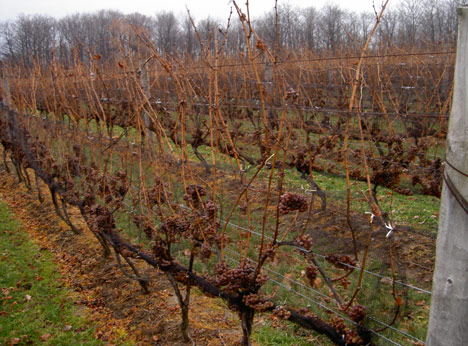 |
| Riesling grapes await the ice wine harvest in December |
For many New World consumers, Eiswein is as quintessentially Canadian as the Toronto Maple Leafs hockey team. The fact that Eiswein is said to have German origins is rather surprising to many in North America, since we keep hearing that Canada is the world's largest producer of Eiswein. The Canadians even have their own term for it, with a slightly different spelling, here it is called "Icewine", the rest of the English-speaking world says "ice wine".
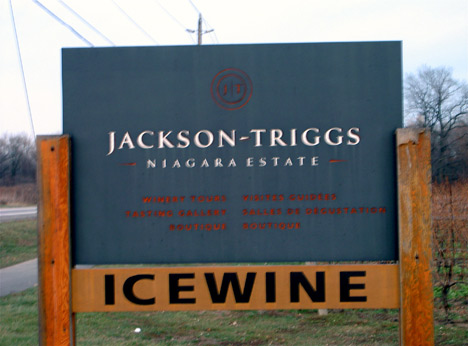 |
The production of ice wine is mostly connected with high risks. In some years the weather does not play along. A mild winter can ruin all plans regarding ice wine production. In Canada, it is a regulation that the temperature must drop to at least -8°C before the frozen grapes can be harvested, from which the sweet, extremely concentrated must can be obtained. This year, for example, most of the grapes used to make ice wine were not harvested until mid-January, so many winemakers were very worried about this early in the season. The yield of frozen grapes is about one fifth compared to grapes for the production of "normal" wine.
It would be wrong to describe Canadian viticulture as a strange niche filled with ice wine. Even though the official wine statistics for Canada report that no less than 900,170 liters of ice wine were produced in Ontario in 2004, many Canadian vintners are meanwhile tired of being taken note of exclusively as producers of ice wine: after all, 99 percent of wine production in Canada consists of "normal" table wine. Others see Canadian ice wine as a unique product that arouses interest and makes consumers aware of the wine-growing country
The Niagara Peninsula
With all this discussion of cold climates and ice wine, it is important to remember that the centre of viticulture in Canada is not the Yukon or Newfoundland. Canada has two major wine growing regions in particular: The Okanagan Valley in the province of British Columbia to the west (near the border with the US, with the US state of Washington on the south side), and the Niagara Peninsula in the province of Ontario to the east.
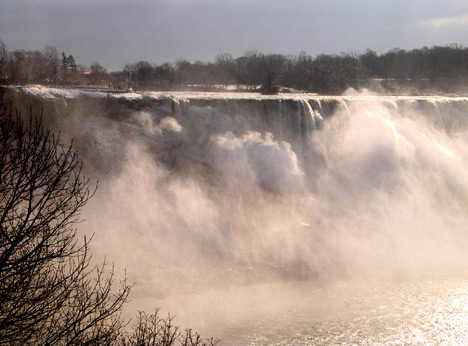 |
| Niagara Falls |
All great wine regions make a point of being different from other areas because of some extraordinary geographical, geological and/or climatic feature. In the case of the Niagara Peninsula in Canada, it is already possible that these distinguishing features go a little further than elsewhere. The first special feature is Lake Ontario, one of the deepest of the Great Lakes, with only Lake Superior in the northwest being deeper. This deep water retains heat in the summer, so the lake serves a balancing function against the cold masses of polar air coming from the north. The second distinctive feature is the Niagara Escarpment, an upthrust dolomitic ridge of rocks with a very steep surface that runs southeast across Ontario State, and continues into New York State. This interesting geological formation has also long been famous for another reason: it is the base of the stone cliffs over which the Niagara River plunges, also known as Niagara Falls.
 |
| Visible primary rock at the Niagara Escarpment |
The core area for viticulture, as dictated by the escarpment, is relatively small, measuring approximately 50 km in length and varying in width from 10 km near the Niagara River to as little as 1 km in the far west of the area. Nevertheless, within this small growing area there are no less than 13 separate sub-areas (sub-appellations) for wine production.
The escarpment, together with the influence of Lake Ontario, results in a moderated climate in the gently sloping region between the escarpment and the lake. The escarpment is up to 25 metres high in places and acts as a barrier, trapping circulating warm and humid air rising from Lake Ontario in this area. This creates a mesoclimate that is much milder than in areas outside this clearly defined region. It is largely thanks to this temperate climate that the Niagara Peninsula has become a successful wine growing region. Len Pennachetti from the Cave Spring Cellars winery calls it a "climatic stroke of luck". With a slight smile, he describes the Niagara Peninsula's temperate climate in contradictory terms as a "maritime-continental climate.".
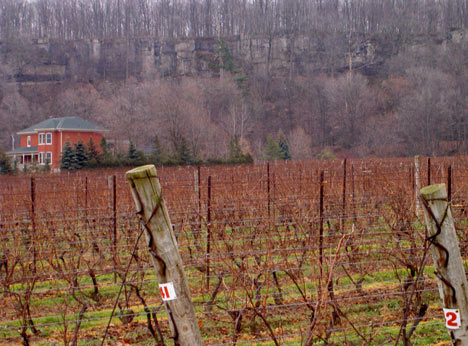 |
| The Niagara Escarpment rises behind the vineyards in the Beamsville region |
In fact, the Niagara Peninsula, eastern Canada's best-known and leading wine-growing region, is located on the south shore of Lake Ontario, about 150 kilometres south of metropolitan Toronto, at roughly the same latitude as Florence, Italy. Yet, the area is still classified as a region with a cool climate. Polar air masses result in unsettled weather in the spring and fall, and winter temperatures are colder than those found in most European cool-climate wine regions.
Because the cool climate is part of the reality of the Niagara Peninsula, care must be taken in selecting grape varieties accordingly. The grape varieties that are planted here can be divided into two or three categories. One could be called the German model. Then there is the second group, the Burgundy model, which is built on Chardonnay and some Pinot Noir. In the third model, all of these grape varieties, and then some, are thrown together in a way that only happens in the New World. On a recent visit to the Niagara Peninsula, in addition to the wines mentioned above, I tasted the following: Gamay, Cabernet Sauvignon, Merlot, Cabernet Franc, Syrah, Pinot Gris, Gewürztraminer, Sauvignon Blanc, Viognier, and Vidal. Vidal covers 20% of the total vineyard area because the variety is very resistant to cold, and is very suitable for ice wine.
Free trade, the VQA, and agritourism
In my conversations with many Canadian wine producers, it was expressed that many agreed that the Free Trade Agreement of 1988 was the precipitating factor that cleared the way for Canadian wines to enter the world market. Until 1988, the Canadian government protected Canadian winemakers from competition. Wines produced in the country from French hybrid varieties and Vitis labrusca (grape varieties such as Concord) were subsidized, so that wines of inferior quality from these grape varieties were much cheaper for the consumer in Canada than imported wines from abroad. As a result, there was no incentive to plant the higher quality but higher risk European grape varieties of the Vitis vinifera species, the group that includes all the best known grape varieties in the world, from Cabernet Sauvignon to Chardonnay. After the removal of protective tariffs, Canadian wines had to compete in their own market against wines from around the world and as a result, the quality of Canadian wines has risen to keep up with the competition.
In 1988, the Canadian government also amended the Wine Content Act, so that since then, the grape varieties of the species Vitis labrusca cannot be used in the production of table wines. In the same year, those Canadian vintners who wanted to improve the reputation of Canadian wine joined the Vintners Quality Alliance (VQA). This is de facto an appellation system, where wine growing regions were defined and quality standards were fixed. The seal of the VQA on a bottle of Canadian wine guarantees a high-quality wine that comes from a clearly defined growing region.
Without much ado, the wine industry on the Niagara Peninsula is coming of age. This may sound strange because "serious" viticulture, i.e. with grape varieties of the Vitis vinifera species, started here as late as in the late 1970ies. Some of the pioneers of the first hour are now slowly reaching retirement age - Karl Kaiser and Donald Ziraldo, the founders of Inniskillin thirty-two years ago, have recently announced their retirement.
Meanwhile, the second generation of winery owners can be seen here, some with fat purses, which they initially filled in completely different professions. You see the winery as an expression of an architectural idea more often now. I see it as a sign of stability. In some ways it reminds me of Napa Valley in California. However, I found the prices of Canadian wines to be much more consumer friendly compared to those of Napa wines.
Wines and Vines magazine from the US reports that 108 new wineries were created in Canada last year. This represents a doubling of the total number in just one year. Thirty-eight of these new wineries are in Ontario alone, bringing the total number in the region to 133 wineries (as of 2006).
Martin Malivoire purchased vineyards for his Malivoire Wine Company winery in 1997. He told me recently at the Canada in New York tasting in New York City that an acre of vineyards on the Niagara Peninsula is already six times more expensive today than it was in 1997.
One complaint I heard from almost all producers was that there is not enough wine to offer at the moment because two of the last three vintages have been decidedly small in volume and demand is so strong at home.
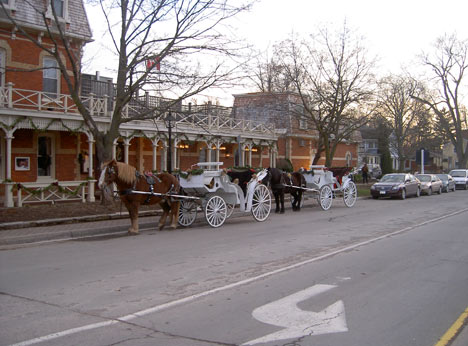 |
| Niagara on the Lake |
Large tracts of professionally farmed, properly aligned and pruned vines dominate the landscape between the lake and the bluffs. Today, agritourism provides additional income to winemakers, who use it to mitigate some of the risks of farming in a cool climate, and in the process attract a loyal following of gourmets and wine lovers from the great metropolis of Toronto and its environs. I was very impressed with the quality of the wines. Wine drinkers in Canada seem to agree with me on this. I was amazed that on a cold Saturday in mid-December, the winery tasting rooms were bursting with people selling not only wine, but everything from wine accessories to clothing. As a result of this growing regional tourism, an area once known only for orchards is morphing into an attractive destination for winery visits.
Wine lovers visiting here will find charming local hotels and restaurants. For example, adjacent to the Cave Spring Cellars winery in Jordan, Ontario is the delightful Inn on the Twenty guesthouse and restaurant, On the Twenty. The term "Twenty" refers to the name of the creek that runs beside it and flows over the bluff into Lake Ontario. If you ever want to visit the region, the Inn on the Twenty makes an ideal rest stop, a pleasant little hotel with friendly service, ideally located for winery visits.
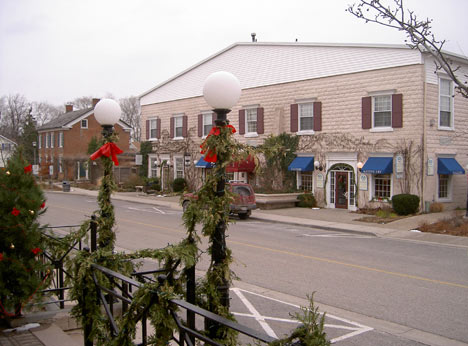 |
| On the Twenty% the restaurant of the winery Cave Spring Cellars% Jordan% Ontario |
Preview of Part ll: Wineries, Winemakers and Wines of the Niagara Peninsula